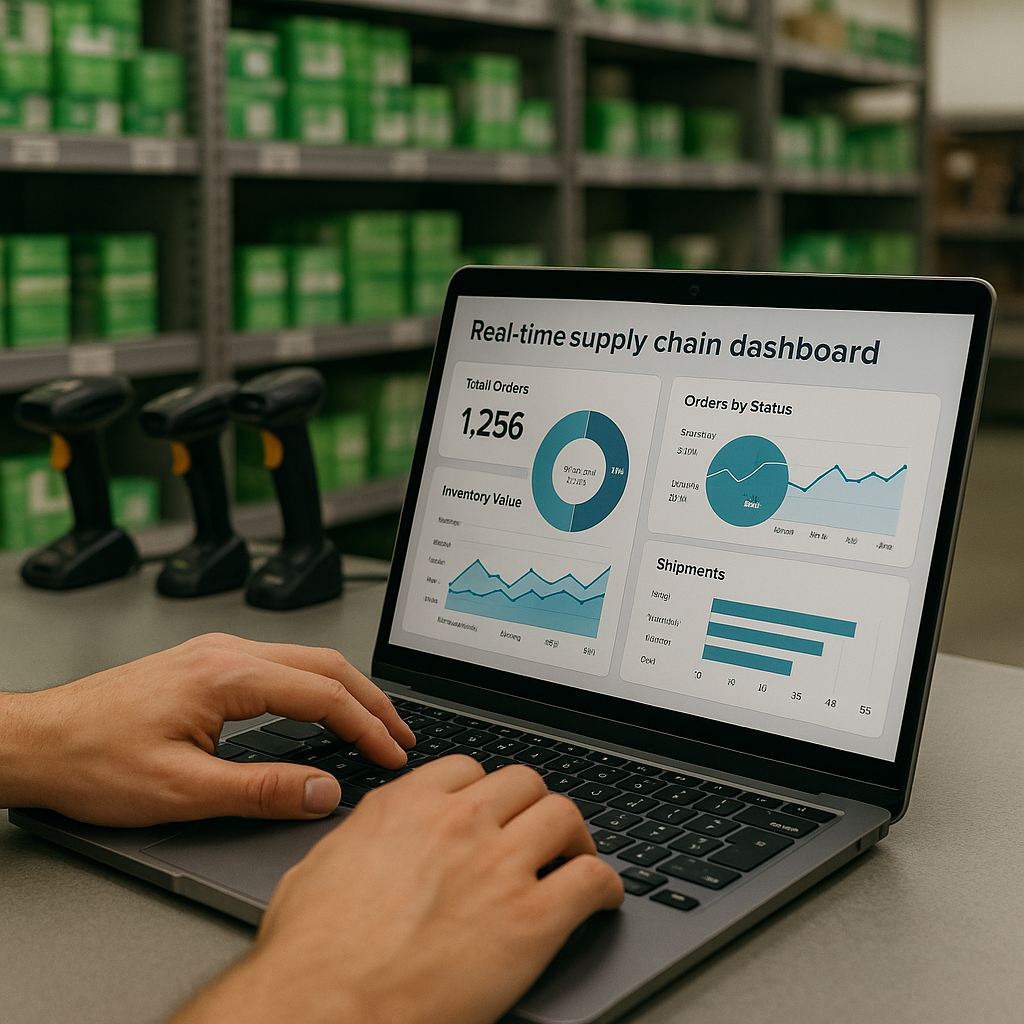5901 Botham Jean Blvd, Dallas, TX 75215
Sustainable Supply Chain Management: Step-by-Step Implementation Guide with Real Metrics
September 12, 2025Sustainable supply chain management integrates environmental, social, and economic factors throughout every stage of the supply chain. It extends beyond traditional supply chain practices by prioritizing sustainability alongside operational efficiency. Companies adopting this approach scrutinize everything from sourcing raw materials to delivering finished products.
The primary goal of sustainable supply chain management is to create business value while minimizing negative impacts on people and the planet. This involves making conscious decisions to lower carbon emissions, reduce waste, and conserve natural resources. It also entails ensuring fair labor conditions, supporting local communities, and maintaining ethical business practices.
The environmental component emphasizes reducing carbon footprints through efficient transportation, renewable energy usage, and responsible resource management. The social aspect addresses fair wages, safe working conditions, and ethical sourcing practices. Meanwhile, the economic dimension balances sustainability investments with financial viability to ensure long-term business success.
Why is Sustainable Supply Chain Management Important?

Supply chains are responsible for up to 90% of a company’s total environmental impact. According to the Carbon Disclosure Project, supply chains generate up to 11.4 times more emissions than a company’s direct operations. This highlights the critical need for sustainable supply chain management in modern businesses.
The environmental benefits of sustainable practices go beyond reducing emissions. By preserving natural resources, minimizing waste, and protecting biodiversity, businesses can decrease their ecological footprint through reuse and recycling programs grounded in circular supply chain principles.
Brand reputation significantly improves through sustainable practices. Today’s consumers often base purchasing decisions on a company’s environmental and social commitments. A 2023 market study found that 61% of companies pursued supply chain sustainability primarily to enhance their reputation and strengthen customer relationships.
Another key advantage is risk mitigation. Sustainable supply chains are inherently more resilient to disruptions from climate events, resource scarcity, and social unrest. By addressing potential vulnerabilities and implementing responsible practices, companies safeguard their operations against both physical and transitional risks.
Adopting sustainable practices often leads to cost reduction. While initial investments in technology and training may be substantial, the long-term savings, achieved through energy-efficient operations, optimized transportation routes, and waste reduction initiatives, are significant. Companies frequently report that these sustainability projects pay for themselves by improving operational efficiency.
Regulatory compliance is essential as stricter environmental and social standards are implemented globally. In Europe, the Corporate Sustainability Due Diligence Directive mandates large companies to identify and address adverse impacts throughout their value chains, with non-compliance leading to significant fines and potential litigation.
Sustainable supply chain management also enhances investor relations. ESG (Environmental, Social, and Governance) metrics increasingly influence investment decisions, access to capital, and insurance rates. A well-managed sustainable supply chain signals long-term viability and operational excellence to potential investors.
Beyond environmental concerns, social responsibility in supply chains impacts fair labor practices, ethical sourcing, and community engagement, contributing to global inequality reduction. These practices ensure that economic growth benefits all stakeholders, not just shareholders.
| Benefit | Category | Details |
|---|---|---|
| Reduced Carbon Emissions | Environmental | Significantly lowers greenhouse gas emissions through efficient transportation, use of renewable energy, and carbon footprint reduction initiatives. |
| Resource Conservation | Environmental | Efforts to conserve natural resources like water and energy, and reduce waste through recycling and reuse programs. |
| Improved Brand Reputation | Social | Enhances consumer trust and loyalty by demonstrating commitment to ethical and sustainable practices. |
| Fair Labor Practices | Social | Ensures safe working conditions, fair wages, and respect for employee rights throughout the supply network. |
| Cost Reduction and Efficiency | Economic | Long-term financial savings from reduced resource consumption, optimized processes, and improved operational efficiencies. |
| Innovation and Competitive Advantage | Economic | Encourages new operational models, technologies, and market opportunities that lead to competitive advantages. |
What Are the Key Components of Sustainable Supply Chain Management?

Sustainable supply chain management takes a comprehensive approach to balancing environmental, social, and economic responsibilities throughout the value chain. Successful implementation of these practices not only minimizes an organization’s ecological footprint but also enhances resilience to market changes and regulatory shifts. Here are the three core pillars of a sustainable supply chain.
Environmental Responsibility
Environmental responsibility aims to reduce the ecological impact of supply chain operations. This includes tracking and lowering carbon emissions across transportation, manufacturing, and distribution networks. Many companies now use carbon footprint tracking tools to monitor their environmental impact and set clear reduction targets.
Waste management is another essential aspect of environmental responsibility. It involves adopting techniques like recycling, reusing materials, and optimizing production processes to reduce landfill waste. Companies excelling in this area often use closed-loop systems where materials are recycled back into production.
Resource conservation is equally important, with sustainable supply chains focusing on minimizing water usage, energy consumption, and raw material inputs. This might involve upgrading facilities with energy-efficient equipment or switching to renewable energy sources. Sustainable sourcing practices ensure raw materials come from suppliers with similar environmental values.
Social Responsibility
The social aspect of sustainable supply chain management looks at the human impact of business operations. Fair labor practices are central to this component, ensuring safe working conditions, appropriate wages, and respect for workers’ rights across the supply network. Companies must prevent human rights violations such as child labor, forced labor, or discrimination within their supplier partnerships.
Community support initiatives show a commitment to positive social impact beyond immediate business operations. This might include investing in local infrastructure, supporting education programs, or providing health services in communities involved in the supply chain. These efforts build goodwill and strengthen stakeholder relationships.
Diversity and inclusion within the supply chain is another aspect of social responsibility. This involves promoting supplier diversity by partnering with minority-owned, women-owned, or other underrepresented enterprises. These practices support social equity and often drive innovation through diverse perspectives.
Economic Efficiency
Economic efficiency ensures that sustainable practices remain viable over the long term. Process optimization plays a key role, with companies streamlining operations to reduce waste, improve productivity, and lower costs. This might involve implementing lean manufacturing principles or redesigning logistics networks to minimize transportation distances.
Cost management balances short-term expenses with long-term savings. Although initial investments in sustainable technologies or practices may be required, they often yield significant returns through reduced resource consumption, lower waste disposal costs, and improved operational efficiency. Companies with a forward-thinking approach recognize that sustainability initiatives can offer substantial financial benefits.
Long-term growth strategies integrate sustainability as a driver of innovation and competitive advantage. By developing products and services that address environmental and social challenges, companies can tap into growing markets for sustainable solutions, positioning them for success in an economy increasingly shaped by sustainability concerns.
Key Strategies for Implementation
Sustainable sourcing is the foundation of an environmentally responsible supply chain. This involves choosing suppliers based on their environmental performance, social practices, and commitment to continuous improvement. Many companies now enforce supplier codes of conduct and conduct regular audits to align with sustainability goals network-wide.
Green logistics focuses on reducing the environmental impact of transportation and distribution activities. Route optimization software helps minimize fuel consumption and emissions by finding the most efficient delivery paths. The switch to electric and hybrid vehicles further decreases reliance on fossil fuels, while sustainable packaging solutions reduce the environmental footprint of product delivery.
Supply chain visibility improves the management of sustainability efforts through enhanced transparency. Digital tools provide real-time data on inventory levels, transportation routes, and supplier performance. This visibility enables companies to pinpoint inefficiencies, track progress toward sustainability goals, and make informed decisions about improvement opportunities.
Stakeholder collaboration acknowledges that sustainability challenges often extend beyond any single organization’s boundaries. By working closely with suppliers, customers, industry peers, and even competitors, companies can create shared solutions to common challenges. These collaborative approaches often deliver greater results than isolated efforts, especially for complex issues like climate change or labor conditions in global supply chains.
| Component | Focus Area | Example Practice |
|---|---|---|
| Environmental Responsibility | Reducing carbon footprints, waste management, resource conservation | Implementing carbon footprint tracking tools, adopting recycling techniques, transitioning to renewable energy sources |
| Social Responsibility | Fair labor practices, community support, diversity and inclusion | Ensuring safe working conditions, supporting local infrastructure, promoting supplier diversity |
| Economic Efficiency | Process optimization, cost management, long-term growth | Streamlining operations, investing in sustainable technologies, developing sustainable product lines |
Technology adoption accelerates progress toward sustainability goals by enhancing efficiency and enabling new capabilities. Automation systems reduce energy consumption while improving productivity. Data analytics offer insights into operational performance and improvement opportunities. Advanced technologies like artificial intelligence optimize resource allocation and predict maintenance needs, further reducing waste and environmental impact.
How Can Technology Enable Sustainable Supply Chain Management?

Modern supply chains face increasing pressure to reduce their environmental impact. Technology provides powerful solutions to these challenges, with several key technologies converging to create opportunities for building truly sustainable supply chains.
Artificial Intelligence: Smarter Decision-Making
AI systems analyze vast datasets to predict product demand with remarkable accuracy. This helps businesses optimize inventory levels, preventing waste from excess production or stockouts.
Companies like PepsiCo use machine learning algorithms to forecast consumer demand patterns, reducing waste from overproduction and minimizing unnecessary energy consumption associated with transporting and storing excess inventory.
AI also optimizes transportation routes by analyzing factors such as traffic patterns, weather conditions, and fuel efficiency. Walmart demonstrates this through its AI-powered routing system, planning deliveries to lower fuel consumption and reduce carbon emissions.
Blockchain: Ensuring Transparency and Trust
Blockchain technology creates an immutable digital ledger recording every transaction across the supply chain. This provides a single source of truth accessible and verifiable by all stakeholders.
Supply chain partners use blockchain to track the origin of raw materials and verify ethical sourcing practices, helping companies ensure compliance with sustainability standards and regulations.
The technology also supports waste reduction initiatives by creating transparent logs of waste metrics, helping businesses identify inefficiencies and optimize resource usage throughout their operations.
Internet of Things: Real-Time Monitoring
IoT devices collect real-time data on products, transportation, and environmental conditions, tracking variables like temperature, humidity, location, and carbon emissions.
When integrated with blockchain, IoT provides comprehensive monitoring of carbon footprints. Sensors measure emissions during production and transportation while blockchain securely stores this data for sustainability reporting and carbon offset initiatives.
IoT devices also facilitate proactive equipment maintenance. By continuously monitoring machinery performance, these systems can detect anomalies and predict failures before they occur, preventing unplanned downtime and reducing resource wastage.
Advanced Analytics: Optimizing Resources
Advanced analytics tools process the massive amounts of data generated by AI, blockchain, and IoT systems, identifying patterns and insights that might be missed by humans.
Companies use these insights to improve resource utilization and reduce environmental impact. Analytics can identify equipment and processes that consume excessive energy and recommend optimization strategies.
Lifecycle analysis is another powerful application, with analytics systems examining data from every stage of a product’s lifecycle—from raw material extraction to disposal—helping companies identify opportunities to reduce environmental impact throughout the value chain.
Integrated Technology Solutions
The true power of these technologies emerges when they work together. For example, IBM Food Trust combines AI, blockchain, and IoT to help companies verify sustainable sourcing practices and fair labor conditions.
Similarly, sustainability ratings agency EcoVadis uses AI to analyze extensive datasets and evaluate suppliers based on environmental, social, and ethical practices, aiding companies in selecting partners that align with their sustainability goals.
As these technologies advance, even more innovative applications can be expected, transforming supply chains from major environmental impact sources into models of sustainability.
Conclusion: The Future of Sustainable Supply Chain Management

Sustainable supply chain management is evolving as businesses increasingly prioritize environmental responsibility alongside operational efficiency. Integrating circular economy principles marks a shift from traditional linear models to systems focused on resource conservation through reuse, recycling, and waste reduction. Companies adopting these practices not only reduce their environmental impact but also often achieve cost savings and improved resilience.
The future of sustainable supply chains will be shaped by innovations in green logistics and advanced technologies like AI, IoT, and blockchain, which enhance transparency and efficiency. Organizations embracing these developments are better positioned to meet increasing regulatory requirements and consumer expectations while maintaining their competitive edge. For assistance with implementing effective recycling programs, contact Okon Recycling at 214-717-4083.
